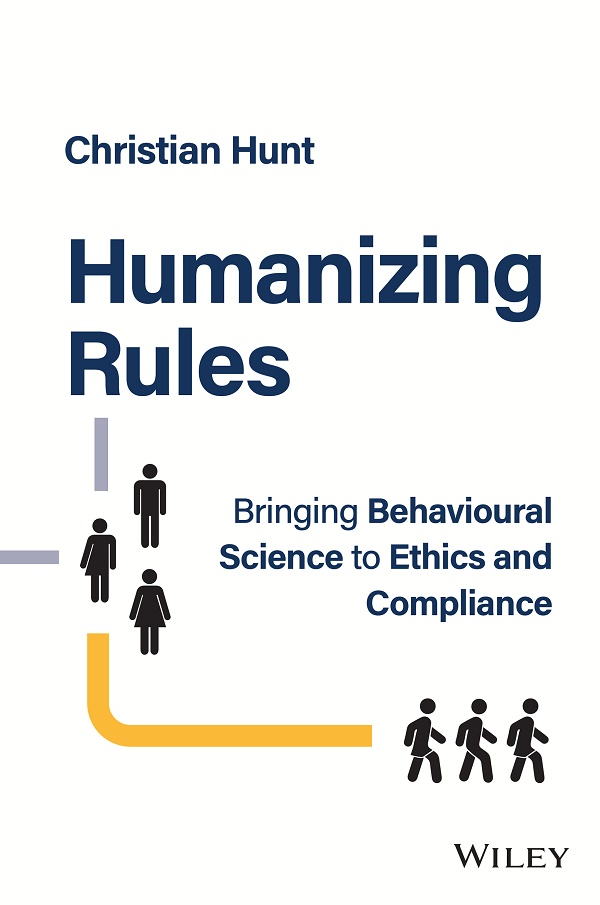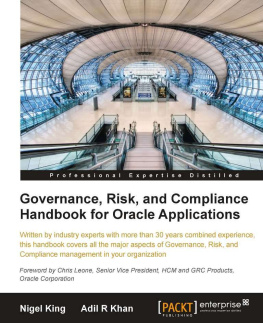
Table of Contents
Guide
Pages
HUMANIZING RULES
BRINGING BEHAVIOURAL SCIENCE TO ETHICS AND COMPLIANCE
CHRISTIAN HUNT

Copyright 2023 by Christian Hunt. All rights reserved.
All rights reserved. No part of this publication may be reproduced, stored in a retrieval system, or transmitted, in any form or by any means, electronic, mechanical, photocopying, recording or otherwise, except as permitted by law. Advice on how to obtain permission to reuse material from this title is available at http://www.wiley.com/go/permissions.
The right of Christian Hunt to be identified as the author of this work has been asserted in accordance with law.
Registered Office(s)
John Wiley & Sons, Inc., 111 River Street, Hoboken, NJ 07030, USA
John Wiley & Sons Ltd, The Atrium, Southern Gate, Chichester, West Sussex, PO19 8SQ, UK
Editorial Office
The Atrium, Southern Gate, Chichester, West Sussex, PO19 8SQ, UK
For details of our global editorial offices, customer services, and more information about Wiley products visit us at www.wiley.com.
Wiley also publishes its books in a variety of electronic formats and by printondemand. Some content that appears in standard print versions of this book may not be available in other formats.
Designations used by companies to distinguish their products are often claimed as trademarks. All brand names and product names used in this book are trade names, service marks, trademarks or registered trademarks of their respective owners. The publisher is not associated with any product or vendor mentioned in this book.
Limit of Liability/Disclaimer of Warranty
While the publisher and authors have used their best efforts in preparing this work, they make no representations or warranties with respect to the accuracy or completeness of the contents of this work and specifically disclaim all warranties, including without limitation any implied warranties of merchantability or fitness for a particular purpose. No warranty may be created or extended by sales representatives, written sales materials or promotional statements for this work. The fact that an organization, website, or product is referred to in this work as a citation and/or potential source of further information does not mean that the publisher and authors endorse the information or services the organization, website, or product may provide or recommendations it may make. This work is sold with the understanding that the publisher is not engaged in rendering professional services. The advice and strategies contained herein may not be suitable for your situation. You should consult with a specialist where appropriate. Further, readers should be aware that websites listed in this work may have changed or disappeared between when this work was written and when it is read. Neither the publisher nor authors shall be liable for any loss of profit or any other commercial damages, including but not limited to special, incidental, consequential, or other damages.
Library of Congress CataloginginPublication Data is Available:
ISBN 9781394177400 (Hardback)
ISBN 9781394187287 (ePDF)
ISBN 9781394187294 (ePub)
Cover Design: Wiley
Cover Image: Misha Shutkevych/Getty Images
PREFACE
What Is This Book About?
Humanizing Rules is a practical guide for anyone whose job involves managing human risk or who is interested in understanding more about it.
What Is Human Risk?
Human risk is the risk of people doing things they shouldn't, or not doing things they should. It's an intentionally broad definition that covers the full range of risks posed by human decisionmaking. It includes wilful acts such as I deliberately set out to commit fraud and human errors such as I was tired and made a mistake.
Human risk is the largest risk facing all organisations and society as a whole. When things go wrong, there is always a human component involved. People either cause problems in the first place or make them worse by how they respond.
Who Is the Book For?
Humanizing Rules is designed for anyone responsible for influencing human decisionmaking to reduce risk or ensure compliance with a set of rules or principles. It can help managers and senior leaders to be more effective in influencing the decisions of their employees and therefore deliver desired business outcomes.
It is also directly relevant to professionals in disciplines such as risk, ethics, legal, and compliance. But it is equally applicable to people in other functions who need to ensure that their fellow employees comply with rules, policies, or procedures. This includes but is not limited to functions like audit, legal, human resources, internal comms, procurement, and health & safety. If your role involves mitigating human risk, then Humanizing Rules is for you.
The book is written for a lay audience with little or no previous knowledge of either theoretical or practical behavioural science.
What Does It Cover?
Humanizing Rules suggests an approach to managing human decisionmaking that fuses creativity and behavioural science, the study of the drivers of human decisionmaking. By bringing behavioural science to compliance, we can be more effective, mitigate human risk, reduce employee frustration, and get the best out of people.
Traditional approaches to managing human risk typically rely heavily on two presumptions. The first is that employers have the right to tell their employees what to do and that employees will therefore comply. The second is that compliance can be motivated via incentives and noncompliance can be deterred via punishment. These presumptions are theoretically correct, but often fail in practice. If we really want to influence human behaviour, we need to humanize our rules.
The book is designed to be practical. As we explore human behaviour, I will share stories and case studies from various industries and contexts. The ideas and suggestions I share have all been developed in the field. Either when I was working at UBS or in collaboration with my Human Risk clients. All of these ideas and suggestions are presented, not so that you can slavishly copy them though if you think they might work in your environment, do feel free but rather to inspire you to come up with your own ideas.
What Doesn't It Cover?
The book is not a stepbystep guide to managing human risk. Nor is it a technical guide to behavioural science or risk management. It is designed to inspire you to think differently about how to approach the challenge and to identify new solutions to old problems.
How Is It Structured?
This book is split into four Parts. begins with a story of a minor error with major consequences that, for reasons I explain, helped to inspire the book. I then explore why we need to humanize rules and how behavioural science can help us to do that. I also explore some basic behavioural science principles and highlight why these are relevant.
introduces HUMANS, a simple, practical framework that will help you to deploy behavioural science techniques in your organisation. If you're introducing something new or refreshing your programme, it'll help you think about how your employees will likely react. If something isn't working as expected, HUMANS can help you diagnose why and improve things. Finally, HUMANS can also help you to predict where other parts of your compliance framework might be under stress and are worthy of your attention.
Next page






